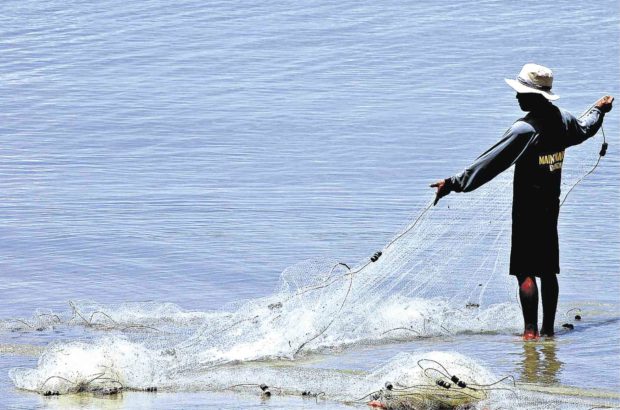
DAY’S WORK A fisherman prepares his net for a fishing trip in Tayabas Bay in Quezon province.
LUCENA CITY—The fish sanctuaries in the bay fronting Lucena City and Pagbilao and Sariaya towns in Quezon province are showing life as sea turtles, manta rays and assorted fish species are starting to return to these areas, an official of an environmental group said.
Zeny Bernal, Tanggol Kalikasan (TK) Southern Luzon program director, said the latest monitoring done by divers from the Bureau of Fisheries and Aquatic Resources (BFAR) confirmed the sanctuaries’ health.
However, not all is rosy in the bay.
Bernal said reports from members of the local bantay dagat (sea patrol) showed dynamite fishing continues in sections of the bay.
Some of these blast fishers belong to a migrant community in the coastal village of Barra in Lucena City that the BFAR has been helping.
“They are using the motorized fishing boats which were given to them by the BFAR,” said Arnel Magadia, a bantay dagat member from Barangay Dalahican.
Magadia is part of a team that patrols the fish sanctuaries off the villages of Barra, Mayao Castillo and Talao-Talao.
He said bantay dagat members could not easily arrest illegal fishers because they were using faster boats.
“We nearly caught some of them last week. They abandoned their fishing boat at the shore of their community in Barra,” said Arnold Carandang, another bantay dagat member in charge of Sariaya town’s fish sanctuary in Barangay San Roque.
Lucena City Mayor Roderick Alcala said he would ask community leaders in Barra to help stop the illegal activity.
“We provided them with fishing boats for their livelihood. But they should not use these in illegal fishing,” he said.
“We’re ready to provide assistance to responsible fishers. But we will not allow any activities that will destroy Tayabas Bay,” Alcala said.
The coastline of Tayabas Bay stretches from San Juan town in Batangas province to the Quezon towns of Sariaya, Pagbilao, Padre Burgos, Agdangan, Unisan, Pitogo, Macalelon, General Luna, Catanauan, Mulanay and San Francisco, and Lucena City.
Illegal and commercial fishing, and pollution have damaged the 287,332-hectare bay, according to a study of TK, a public interest law office which advocates environmental protection.
Reef conditions have deteriorated due to dynamite and cyanide fishing, while mangrove forests along the coastline have been degraded or destroyed, it said.
TK has started a rehabilitation project aimed at reducing threats and improving sustainable management of marine resources in the Tayabas and Pagbilao bays. —DELFIN T. MALLARI JR.